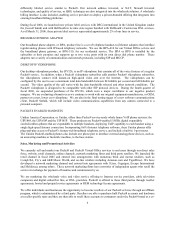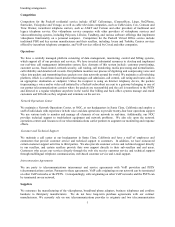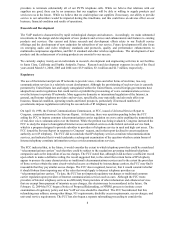8x8 2006 Annual Report Download - page 19
Download and view the complete annual report
Please find page 19 of the 2006 8x8 annual report below. You can navigate through the pages in the report by either clicking on the pages listed below, or by using the keyword search tool below to find specific information within the annual report.16
may be magnified by our inability to adjust spending to compensate for such shortfall. Announcements by our
competitors or us of new products and technologies could cause customers to defer purchases of our existing
products, which would also have a material adverse effect on our business and operating results.
Due to these and other factors, we believe that period-to-period comparisons of our results of operations are not
meaningful and should not be relied upon as indicators of our future performance. It is possible that in some future
periods our results of operations may be below the expectations of public market analysts and investors. If this were
to occur, the price of our common stock would likely decline significantly.
The VoIP telephony market is subject to rapid technological change and we depend on new product and
service introductions in order to maintain and grow our business.
VoIP telephony is an emerging market that is characterized by rapid changes in customer requirements, frequent
introductions of new and enhanced products, and continuing and rapid technological advancement. To compete
successfully in this emerging market, we must continue to design, develop, manufacture, and sell new and enhanced
VoIP telephony software products and services that provide increasingly higher levels of performance and reliability
at lower cost. These new and enhanced products must take advantage of technological advancements and changes,
and respond to new customer requirements. Our success in designing, developing, manufacturing, and selling such
products and services will depend on a variety of factors, including:
• the identification of market demand for new products;
• the scalability of our VoIP telephony software products;
• product and feature selection;
• timely implementation of product design and development;
• product performance;
• cost-effectiveness of current products and services and products under development;
• our ability to successfully implement service features mandated by federal and state law;
• effective manufacturing processes; and
• effectiveness of promotional efforts.
Additionally, we may also be required to collaborate with third parties to develop our products and may not be able
to do so on a timely and cost-effective basis, if at all. We have in the past experienced delays in the development of
new products and the enhancement of existing products, and such delays will likely occur in the future. If we are
unable, due to resource constraints or technological or other reasons, to develop and introduce new or enhanced
products in a timely manner, if such new or enhanced products do not achieve sufficient market acceptance, or if
such new product introductions decrease demand for existing products, our operating results would decline and our
business would not grow.
Decreasing telecommunications rates may diminish or eliminate our competitive pricing advantage.
Decreasing telecommunications rates may diminish or eliminate the competitive pricing advantage of our services.
International and domestic telecommunications rates have decreased significantly over the last few years in most of
the markets in which we operate, and we anticipate that rates will continue to be reduced in all of the markets in
which we do business or expect to do business. Users who select our services to take advantage of the current
pricing differential between traditional telecommunications rates and our rates may switch to traditional
telecommunications carriers as such pricing differentials diminish or disappear, and we will be unable to use such
pricing differentials to attract new customers in the future. In addition, our ability to market our services to other
service providers depends upon the existence of spreads between the rates offered by us and the rates offered by
traditional telecommunications carriers, as well as a spread between the retail and wholesale rates charged by the
carriers from which we obtain wholesale services. Continued rate decreases will require us to lower our rates to
remain competitive and will reduce or possibly eliminate any gross profit from our services. If telecommunications
rates continue to decline, we may lose subscribers for our services.
























